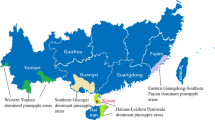Abstract
It is well known that wild carrots may pollute the seed cropsof cultivated carrots, but whether cultivated carrots can alsodisperse pollen and seed, and thereby introduce genes into wildcarrot populations, is only little described. In Denmark, there is nocommercial seed production of carrots, and as biennials they shouldnormally not flower before harvest of the roots. Still, floweringindividuals can be found in most Danish fields, and sometimes in veryhigh numbers. At least 75% of the flowering plants are malefertile, with ca. 83% of the pollen being viable. More thanhalf of the plants produce seeds. Pollen and seed dispersal fromfields into wild carrot populations is probably rather frequent inDenmark. A closer inspection of the morphology of flowering plantsindicate that some of these (2–60%) arebolters of pure cultivar origin, as indicated primarily by orangeroot colour. The remainder is probably first or advanced generationhybrids between wild and cultivated plants, as indicated by theirwhite roots and combinations of morphological characters from eitherplant type. Some of these hybrids are imported to Denmark togetherwith the sowing seed, as indicated by significantly differentfrequencies of bolters with white roots in different carrot cultivarstested in the field.
Similar content being viewed by others
References
Atherton J.G., Craigon J. and Basher E.A. 1990. Flowering and Our results show that there is a clear potential for bolting in carrot. I. Juvenility, cardinal temperatures and thermal introgression from cultivated to wild carrots in Den-times for vernalization. J. Hort. Sci. 65: 423–429.
Banga O. 1957a. Origin of the European cultivated carrot. and in the seed production areas in warmer regions, Euphytica 6: 54–63.
Banga O. 1957b. The development of the original European carrot material. Euphytica 6: 64–76.
Barrett S.C.H. 1983. Crop mimicry in weeds. Econ. Bot. 37: 255–282.
Bjørn G.K. 1999. Varieties of carrot (in Danish). DJF Rapport 7. Danmarks Jordbrugsforskning, Denmark.
Bjørn G.K., Hagelskjær L. and Kidmose U. 1994. Varieties of carrot. SP Rapport Nr. 42. Statens Planteavlsforsøg, Denmark.
Buishand J.G. and Gabelman W.H. 1979. Investigations on the inheritance of color and carotenoid content in phloem and xylem of carrot roots (Daucus carota L.). Euphytica 28: 611–632.
D'Antuono L.F. 1985. Studio sull'inquinamento genetico causato da polline de tipi spontanei in carota da seme. Rivista di Agronomia 19: 297–304.
Desplanque B., Boudry P., Broomberg K., Saumitou-Laprade P., Cuguen J. and Van Dijk H. 1999. Genetic diversity and gene flow between wild, cultivated and weedy forms of Beta vulgaris L. (Chenopodiaceae), assessed by RFLP and microsattellite markers. Theor. Appl. Genet. 98: 1194–1201.
Ellstrand N.C. 1992. Gene flow by pollen: implications for plant conservation genetics. OIKOS 63: 77–86.
Ellstrand N.C., Prentice H.C. and Hancock J.F. 1999. Gene flow and introgression from domesticated plants into their wild rela-tives. Ann. Rev. Ecol. Syst. 30: 539–563.
Gary N.E., Witherell P.C. and Marston J. 1972. Foraging range and distribution of honey bees used for carrot and onion pollination. Envir. Entomol. 1: 71–78.
Gary N.E., Witherell P.C., Lorenzen K. and Marston J.M. 1977. The interfield distribution of honey bees foraging on carrots, onions, and safflower. Envir. Entomo. 6: 637–640.
Harlan J.R. 1965. The possible role of weed races in the evolution of cultivated plants. Euphytica 14: 173–176.
Heywood V.H. 1983. Relationships and evolution in the Daucus carota complex. Israel J. Bot. 32: 51–65.
Levin D.A., Francisco-Ortega J. and Jansen R.K. 1996. Hybridization and the extinction of rare plant species. Conserv. Biol. 10: 10–16.
Phillips R.L. 1981. Pollen and pollen tubes. In: Clark G (ed.), Staining Procedures. Williams and Wilkins, Baltimore, MD, pp. 361–366.
Rieseberg L.H. and Wendel J.F. 1993. Introgression and its consequences in plants. In: Harrison R.G (ed.), Hybrid Zones and the Evolutionary Process. Oxford University Press, New York, pp. 70–109.
SAS 1990. SAS/STAT User's Guide. Version 6. SAS Institute, Cary, NC.
Small E. 1978. A numerical taxonomic analysis of the Daucus carota complex. Can. J. Bot. 56: 248–276.
Small E. 1984. Hybridization in the domesticated-weed-wild complex. In: Grant W.F (ed.), Plant Biosystematics. Academic Press, Toronto, pp. 195–210.
Snow A.A. and Palma P.M. 1997. Commercialization of transgenic plants: potential ecological risks. BioScience 47: 86–96.
Van Raamsdonk L.W.D. and Van Der Maesen L.J.G. 1996. Crop-weed complexes: the complex relationship between crop plants and their wild relatives. Acta Bot. Neerl. 45: 135–155.
Wijnheijmer E.H.M., Brandenburg W.A. and Ter Borg S.J. 1989. Interactions between wild and cultivated carrots (Daucus carota L.) in the Netherlands. Euphytica 40: 147–154.
Author information
Authors and Affiliations
Rights and permissions
About this article
Cite this article
Hauser, T.P., Bjørn, G.K. Hybrids between wild and cultivated carrots in Danish carrotfields. Genetic Resources and Crop Evolution 48, 499–506 (2001). https://doi.org/10.1023/A:1012051731933
Issue Date:
DOI: https://doi.org/10.1023/A:1012051731933




